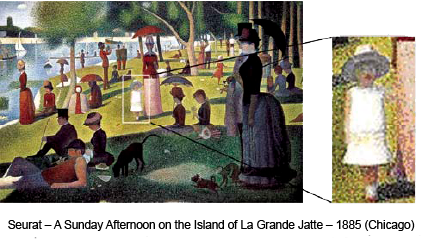B1.1 Read, represent, compose, and decompose whole numbers up to and including 100 000, using appropriate tools and strategies, and describe various ways they are used in everyday life.
Activity 1: Small Dots
This activity integrates concepts from the Number strand as well as from the Arts curriculum.

Note: Georges Seurat (1859-1891) was a French neo-impressionist artist known for his pointillism technique. This technique consists of painting by juxtaposing small dots of paint whose colours influence each other, modifying the intensity of their tone and then harmonizing to create the impression of a realistic image. Seurat's best-known work made using this technique, A Sunday Afternoon on the Island of La Grande Jatte, required two years of work.
Introduce students to the painting A Sunday Afternoon on the Island of La Grande Jatte and briefly explain the pointillism technique used by Seurat. Tell them that the painting measures approximately 2 m by 3 m, and then encourage them to think about how many small brushstrokes were required to make the entire painting. Next, have the students create a collective work of art based on the pointillism technique. The work will be done on a legal size sheet of paper (21.6 cm by 35.6 cm). Show students a set of coloured markers and ask them to estimate how many dots they will need to make with the markers to complete the work. Students may spontaneously suggest numbers, but since they do not have any benchmark quantities to work with, there may be a wide range of answers. Ask them if they can suggest a strategy that would allow them to formulate a reasonable estimation. For example, students can suggest that they draw a square with dimensions of 1 cm by 1 cm and count the number of dots needed to fill it.
Note: Typically, students can complete such a square in one to two minutes by drawing about 130 dots with a fine point marker. Using this benchmark quantity and after determining that the area of the work is about 700 cm2, students can estimate that it will take about 100 000 dots to complete the work.
Then discuss with the class the meaning of their estimations by asking questions such as:
- Will there be exactly 100 000 dots? Could there really be 104 325, 60 000, 364 250 or 93 254 dots?
By completing the work, students will have the opportunity to see what area approximately 100 000 dots covers, giving them a sense of this number.
Then suggest that the students create the work collectively, following certain conditions. For example, the teacher can cut a sheet of paper into sections and ask each student to complete one of the sections, tracking the number of dots they've drawn. This work can be spread out over several days for five to ten minutes a day. When all the students have finished, assemble the sections and calculate the total number of dots recorded by each student. It is then relevant to compare this total with the estimations given at the beginning of the activity.
Ask students to estimate how many days it would have taken for a student to complete the entire work, without assistance, at a rate of five minutes per day. For example, by estimating that they can fill in 3 cm2 of the work in five minutes, students can determine that it will take about 230 days to fill in the 700 cm2, which is longer than the entire school year. If desired, repeat this estimation exercise as a class by changing the number of minutes allotted to complete the work each day or the number of students working on it.
This is a good opportunity to make connections between pointillism and technology using the example of digital printers and cameras. Printing resolution is determined in dots per inch (DPI). The higher the number of dots per inch, the better the print quality. At the same time, the resolution of a digital image is defined by the number of pixels that make up the image. A photo taken with a resolution of 5 megapixels (5 million pixels) will therefore have better definition than one taken with a resolution of 1 megapixel.
Source: translated from Guide d'enseignement efficace des mathématiques de la 4e à la 6e année, Numération et sens du nombre, Fascicule 1, Nombres naturels, p. 156-158.
Activity 2: Calling Out the Numbers
Prepare cards like the ones below using numbers up to 100 000.
Distribute all the cards to the students. Depending on the number of students in the class, some students may receive two cards. Choose a student at random and ask them to read the question on the card: Who has the number equal to…. The student who has the card with the answer to the question on it must answer (I have…), then read the question on their card.
Continue the game until you return to the first question.
| Decomposition |
|---|
|
I have 1234. Who has the number equal to \(10\;000\; + \;3\;000\; + \;500\; + \;3\) ? |
|
I have 13 503. Who has the number equal to \(1200\; + \;34\) ? |
Activity 3: Featured Number
Each week, present a featured number to students between 10 000 and 100 000.
In pairs, ask them to determine different representations of the featured number (for example, in words, on an open number line, by decomposing the number, etc.)
Pool the results to bring out all the representations.
Ask students where they might find this number in their daily lives.
Post the students' ideas and add more representations throughout the week.
